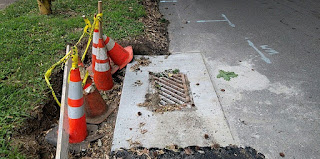As a new resident of Cincinnati it would be easy to dismiss the entire MSD for the alleged actions (or inaction) of these top managers. The MSD is actually several hundred people. From what I have seen those who are responsible for keeping the system running take that task seriously.
I recently had the opportunity to use the 'Fix it Cincy!' smartphone application for the first time. As an avid dog walker I saw a number of problems after a storm and reported clogged rainwater intakes using the app. Before I finished my walk I got a call from the MSD asking me to clarify what what happening. The MSD sent a truck out and the clogged intakes were remediated the same day as my reporting the problems.
I also reported more complex erosion problems that had been developing over time. The washouts were, in my opinion, deep enough to be safety issues. On the same call with the city I described the problems observed and was told that those issues would take some time to fix as a contractor would need to be sent out to design a repair. Within a month the two issues that required contracting were also resolved. The contractors also drove though the Sayler Park neighborhood of Cincinnati noting other items for repair and those were also addressed.
While it might seem that the repairs are 'mundane and expected' considerable effort was put in to make the work as permanent as possible. The areas were dug out, cement poured, dirt repacked, the dirt seeded and the road repaired next to the erosion. A recent letter to the Cincinnati Enquirer editor was critical of what 600 MSD employees do all day...I can say a good number are working hard.
 |
| repairs complete (click images to enlarge) |
While the news regarding the senior management at the MSD is an unfolding soap opera it would be unfair to paint the entire department with the same brush. In remediation of day-to-day issues I have been very impressed with the MSD. I have never lived in a city before where reported problems got a callback within 10 minutes and would never have expected action to start the same day.
I hope the City Council takes action to get the right management in place for the MSD. The new managment will be getting a caring team that is performing well beyond expectation for what I expect the morale of the department to be given the months of critical press.
Now if we could get that combined sewer issue resolved...


